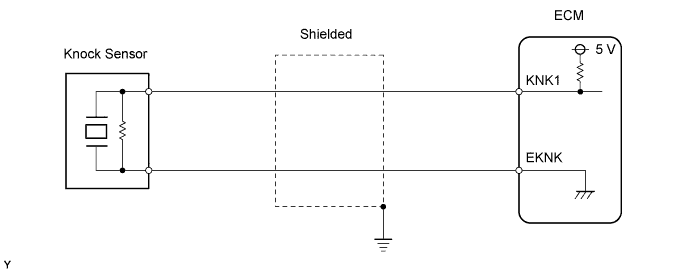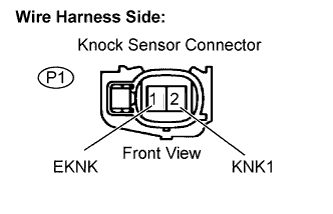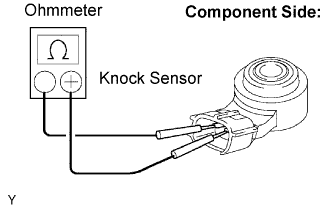Dtc P0327 Knock Sensor 1 Circuit Low Input (Bank 1 Or Single Sensor)
DESCRIPTION
MONITOR DESCRIPTION
MONITOR STRATEGY
TYPICAL ENABLING CONDITIONS
TYPICAL MALFUNCTION THRESHOLDS
CONFIRMATION DRIVING PATTERN
WIRING DIAGRAM
INSPECTION PROCEDURE
READ VALUE USING TECHSTREAM (KNOCK FEEDBACK VALUE)
CHECK HARNESS AND CONNECTOR (ECM - KNOCK SENSOR)
INSPECT ECM (KNK1 VOLTAGE)
INSPECT KNOCK SENSOR
DTC P0327 Knock Sensor 1 Circuit Low Input (Bank 1 or Single Sensor) |
DTC P0328 Knock Sensor 1 Circuit High Input (Bank 1 or Single Sensor) |
DESCRIPTION
The flat type knock sensor (non-resonant type) has structures that can detect vibrations over a wide band of frequencies: between approximately 5 kHz and 15 kHz. A knock sensor is fitted onto the engine block to detect engine knocking.The knock sensor contains a piezoelectric element which generates a voltage when it becomes deformed.The voltage is generated when the engine block vibrates due to knocking. Any occurrence of engine knocking can be suppressed by delaying the ignition timing.DTC No.
| DTC Detection Condition
| Trouble Area
|
P0327
| Output voltage of knock sensor less than 0.5 V
(1 trip detection logic)
| - Short in knock sensor circuit
- Knock sensor
- ECM
|
P0328
| Output voltage of knock sensor more than 4.5 V
(1 trip detection logic)
| - Open in knock sensor circuit
- Knock sensor
- ECM
|
- HINT:
- When any of DTCs P0327 and P0328 are stored, the ECM enters fail-safe mode. During fail-safe mode, the ignition timing is delayed to its maximum retardation. Fail-safe mode continues until the ignition switch is turned to OFF.
Reference: Inspection using an oscilloscope. The correct waveform is as shown.
The correct waveform is as shown.Item
| Content
|
Terminals
| KNK1 - EKNK
|
Equipment Settings
| 1 V/DIV
1 msec./DIV
|
Conditions
| Keep engine speed at 4000 rpm with warm engine
|
MONITOR DESCRIPTION
If the output voltage transmitted by the knock sensor remains low or high for more than 1 second, the ECM interprets this as a malfunction in the sensor circuit, and stores a DTC.The monitor for DTCs P0327 and P0328 begins to run when 5 seconds have elapsed since the engine was started.If the malfunction is not repaired successfully, either DTC P0327 or P0328 is stored 5 seconds after the engine is next started.
MONITOR STRATEGY
Related DTCs
| P0327: Knock sensor range check (Low voltage)
P0328: Knock sensor range check (High voltage)
|
Required Sensors/Components (Main)
| Knock sensor
|
Required Sensors/Components (Related)
| -
|
Frequency of Operation
| Continuous
|
Duration
| 1 second
|
MIL Operation
| Immediate
|
Sequence of Operation
| None
|
TYPICAL ENABLING CONDITIONS
Monitor runs whenever following DTCs not present
| None
|
Battery voltage
| 10.5 V or more
|
Time after engine start
| 5 seconds or more
|
TYPICAL MALFUNCTION THRESHOLDS
Knock Sensor Range Check (Low voltage) P0327:Knock sensor voltage
| Less than 0.5 V
|
Knock Sensor Range Check (High voltage) P0328:Knock sensor voltage
| More than 4.5 V
|
CONFIRMATION DRIVING PATTERN
- Connect the Techstream to the DLC3.
- Turn the ignition switch to ON and turn the Techstream on.
- Clear DTCs (even if no DTCs are stored, perform the clear DTC operation).
- Turn the ignition switch off and wait for at least 30 seconds.
- Turn the ignition switch to ON and turn the Techstream on.
- Start the engine and wait 5 seconds.
- Enter the following menus: Powertrain / Engine and ECT / Trouble Codes.
- Read pending DTCs.
- HINT:
- If a pending DTC is output, the system is malfunctioning.
- If a pending DTC is not output, perform the following procedure.
- Enter the following menus: Powertrain / Engine and ECT / Utility / All Readiness.
- Input the DTC: P0327 or P0328.
- Check the DTC judgment result.
Techstream Display
| Description
|
NORMAL
| - DTC judgment completed
- System normal
|
ABNORMAL
| - DTC judgment completed
- System abnormal
|
INCOMPLETE
| - DTC judgment not completed
- Perform driving pattern after confirming DTC enabling conditions
|
N/A
| - Unable to perform DTC judgment
- Number of DTCs which do not fulfill DTC preconditions has reached ECU memory limit
|
- HINT:
- If the judgment result shows NORMAL, the system is normal.
- If the judgment result shows ABNORMAL, the system has a malfunction.
- If the judgment result shows INCOMPLETE or N/A, idle the engine for 5 minutes and check the DTC judgment result again.
- If no pending DTC is output, perform a universal trip and check for permanent DTCs (YARIS_NCP93 RM000000PDK0QGX.html).
- HINT:
- If a permanent DTC is output, the system is malfunctioning.
- If no permanent DTC is output, the system is normal.
WIRING DIAGRAM
INSPECTION PROCEDURE
- HINT:
- Read freeze frame data using the Techstream. The ECM records vehicle and driving condition information as freeze frame data the moment a DTC is stored. When troubleshooting, freeze frame data can help determine if the vehicle was moving or stationary, if the engine was warmed up or not, if the air fuel ratio was lean or rich, and other data from the time the malfunction occurred.
| 1.READ VALUE USING TECHSTREAM (KNOCK FEEDBACK VALUE) |
Connect the Techstream to the DLC3.
Start the engine and turn the Techstream on.
Warm up the engine.
Enter the following menus: Powertrain / Engine and ECT / Knock Feedback Value.
Read the values displayed on the Techstream while driving the vehicle.
- OK:
- The values change.
HINTMalfunction does not occur
| Knock Feedback Values change
|
Malfunctions occur
| Knock Feedback Values do not change
|
- HINT:
- The knock feedback value change can be confirmed by running the engine at high load, for example, by activating the air conditioning system and revving the engine.
| 2.CHECK HARNESS AND CONNECTOR (ECM - KNOCK SENSOR) |
Disconnect the C20 ECM connector.
Measure the resistance between the terminals.
- Standard resistance:
Tester Connections
| Specified Conditions
|
KNK1 (C20-110) - EKNK (C20-111)
| 120 to 280 kΩ at 20°C (68°F)
|
Reconnect the ECM connector.
| 3.INSPECT ECM (KNK1 VOLTAGE) |
Disconnect the P1 knock sensor connector.
Turn the ignition switch to ON.
Measure the voltage between the knock sensor terminals.
- Standard voltage:
Tester Connections
| Specified Conditions
|
KNK1 (P1-2) - EKNK (P1-1)
| 4.5 to 5.5 V
|
Reconnect the knock sensor connector.
- NOTICE:
- Fault may be intermittent. Check the wire harness and connectors carefully and retest.
Remove the knock sensor.
Measure the resistance between the terminals.
- Standard resistance:
Tester Connections
| Specified Conditions
|
KNK1 (2) - EKNK (1)
| 120 to 280 kΩ at 20°C (68°F)
|
Reinstall the knock sensor.
| OK |
|
|
|
| REPAIR OR REPLACE HARNESS OR CONNECTOR (ECM - KNOCK SENSOR) |
|




